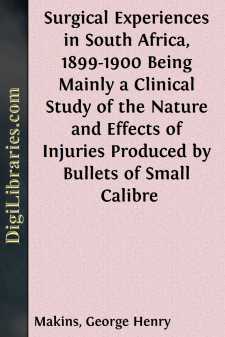Categories
- Antiques & Collectibles 13
- Architecture 36
- Art 48
- Bibles 22
- Biography & Autobiography 813
- Body, Mind & Spirit 142
- Business & Economics 28
- Children's Books 14
- Children's Fiction 11
- Computers 4
- Cooking 94
- Crafts & Hobbies 4
- Drama 346
- Education 46
- Family & Relationships 57
- Fiction 11828
- Games 19
- Gardening 17
- Health & Fitness 34
- History 1377
- House & Home 1
- Humor 147
- Juvenile Fiction 1873
- Juvenile Nonfiction 202
- Language Arts & Disciplines 88
- Law 16
- Literary Collections 686
- Literary Criticism 179
- Mathematics 13
- Medical 41
- Music 40
- Nature 179
- Non-Classifiable 1768
- Performing Arts 7
- Periodicals 1453
- Philosophy 64
- Photography 2
- Poetry 896
- Political Science 203
- Psychology 42
- Reference 154
- Religion 513
- Science 126
- Self-Help 84
- Social Science 81
- Sports & Recreation 34
- Study Aids 3
- Technology & Engineering 59
- Transportation 23
- Travel 463
- True Crime 29
Surgical Experiences in South Africa, 1899-1900 Being Mainly a Clinical Study of the Nature and Effects of Injuries Produced by Bullets of Small Calibre
Description:
Excerpt
CHAPTER I
INTRODUCTORY
The following pages are intended to give an account of personal experience of the gunshot wounds observed during the South African campaign in 1899 and 1900. For this reason few cases are quoted beyond those coming under my own immediate observation, and in the few instances where others are made use of the source of quotation is indicated. It will be noted that my experience was almost entirely confined to bullet wounds, and in this respect it no doubt differs from that of surgeons employed in Natal, where shell injuries were more numerous. This is, however, of the less moment for my purpose as there is probably little to add regarding shell injuries to what is already known, while, on the other hand, the opportunity of observing large numbers of injuries from rifle bullets of small calibre has not previously been afforded to British surgeons.
I think the general trend of the observations goes to show that the employment of bullets of small calibre is all to the advantage of the men wounded, except in so far as the increased possibilities of the range of fire may augment the number of individuals hit; also that such variations as exist between wounds inflicted by bullets of the Martini-Henry and Mauser types respectively, depend rather on the form and bulk of the projectile than on any inherent difference in the nature of the injuries. Thus in the chapter devoted to the general characters of the wounds, it will be seen that most of the older types of entry and exit aperture are produced in miniature by the small modern bullet, and that the main peculiarity of the deeper injuries is the frequent strict localisation of the direct damage to an area of no greater width than that crossed by narrow structures of importance such as arteries or nerves.
It is to be regretted that I am unable to furnish any important statistical details, but incomplete numbers, such as are at my disposal, would be of little value. In view, however, of the considerable interval which must elapse before the Royal Army Medical Corps is able to arrange and publish the large material which will have accumulated, it has seemed unwise to defer publication until the completion of a report which will deal with such matters thoroughly.
It may be of interest to premise the opportunities which I enjoyed of gaining experience during the campaign. I arrived in South Africa on November 19, 1899; two days later I proceeded to Orange River with Surgeon-General Wilson, and on the day three weeks after leaving home performed some operations in the field hospitals on patients from the battle of Belmont. I remained at Orange River during the three next engagements, Graspan, Enslin, and Modder River, and on the day of Magersfontein I went forward to the Field hospitals at Modder River, arriving during the bringing in of the patients from the field of battle. I returned to Orange River with the patients and remained there a further period of three weeks, during which time the patients were gradually transferred to the Base hospitals at Wynberg. At Christmas I followed the patients down to the base, and thus was able to observe the course of the cases from their commencement to convalescence. I remained at Wynberg six weeks, during which time a number of cases from the neighbourhood of Rensburg and some from Natal were received. On February 7, I left Wynberg, following Lord Roberts up to my old quarters at Modder River, where I saw a few wounded men brought in from the engagements at Koodoosberg Drift. On Lord Roberts's departure for Bloemfontein he requested me to return to Wynberg to await the wounded who might be sent down from the fighting which might occur during his advance. I therefore had the disappointment of seeing the start of the army, and then returning to Wynberg, where I remained for another six weeks in attendance at Nos. 1 and 2 General Hospitals.
During this period a very large number of the wounded from Paardeberg Drift and other battles were sent down and treated, after which surgical work began to flag.
On April 14, I was recalled to the front and journeyed to Bloemfontein, where I stayed three weeks, making one journey out to the Bearer Company of the IX. Division at the Waterworks.
On May 4, I left Bloemfontein with Lord Roberts's army, and shortly after joined the IX. Division, with which I journeyed until the commencement of June, seeing a good deal of scattered work in the field and Field hospitals, and in the small temporary improvised hospitals in the towns of Winberg, Lindley, and Heilbron....


